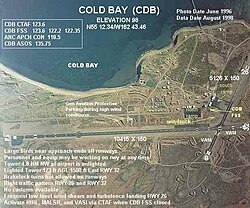Thornbrough Air Force Base
| Thornbrough Air Force Base | |||||||||||||||
|---|---|---|---|---|---|---|---|---|---|---|---|---|---|---|---|
 |
|||||||||||||||
| Summary | |||||||||||||||
| Airport type | Public | ||||||||||||||
| Owner | State of Alaska DOT&PF - Central Region | ||||||||||||||
| Serves | Cold Bay, Alaska | ||||||||||||||
| Hub for | PenAir | ||||||||||||||
| Elevation AMSL | 101 ft / 31 m | ||||||||||||||
| Coordinates | 55°12′19″N 162°43′28″W / 55.20528°N 162.72444°WCoordinates: 55°12′19″N 162°43′28″W / 55.20528°N 162.72444°W | ||||||||||||||
| Map | |||||||||||||||
| Location of airport in Alaska | |||||||||||||||
| Runways | |||||||||||||||
|
|||||||||||||||
| Statistics (2011) | |||||||||||||||
|
|||||||||||||||
| Aircraft operations | 9,210 |
|---|
Thornbrough Air Force Base is a former facility of the United States Air Force in Cold Bay, Alaska. Following its closure, it was redeveloped into Cold Bay Airport.
The airport was constructed during World War II as Fort Randall Army Airfield during the secret military buildup of the Territory of Alaska that began in 1941. Originally, the equipment was supposed to construct McGrath Army Airbase, but the ground had frozen by the time that the equipment arrived. Disguised as civilian employees of the Blair Canning and Packing Company, United States Army personnel in civilian clothes were shipped to Cold Bay. Construction began in December 1941, and the airfield was ready for operation by March 1942. Because of the foresight of Alaska's military commanders, the new airfield, along with another new secret airfield, Cape Field at Umnak, was ready to contribute to the defense of Alaska against Imperial Japanese Navy air attack during the Battle of Dutch Harbor in June 1942. The airfield at Cold Bay remained operational throughout World War II.
Known units assigned to Fort Randall Army Airfield (AAF) were:
Fort Randall AAF was also used by the United States Navy during the Aleutian campaign. A two-gun 6-inch (152-mm) naval gun battery was located at Grant Point. One gun is on display near the town dump. A four-gun 155 mm gun battery on Panama mounts was located at Mortensen's Lagoon at Thin Point. The HECP bunker still exists at Pride Lake.
In the spring and summer of 1945, Cold Bay was the site of the largest and most ambitious transfer program of World War II, Project Hula, in which the United States transferred 149 ships and craft to the Soviet Union and trained 12,000 Soviet personnel in their operation in anticipation of the Soviet Union entering the war against Japan. Fort Randall provided housing and classroom space for the instructors and trainees. At any given time, about 1,500 American personnel were at Cold Bay and Fort Randall during Project Hula.
...
Wikipedia

